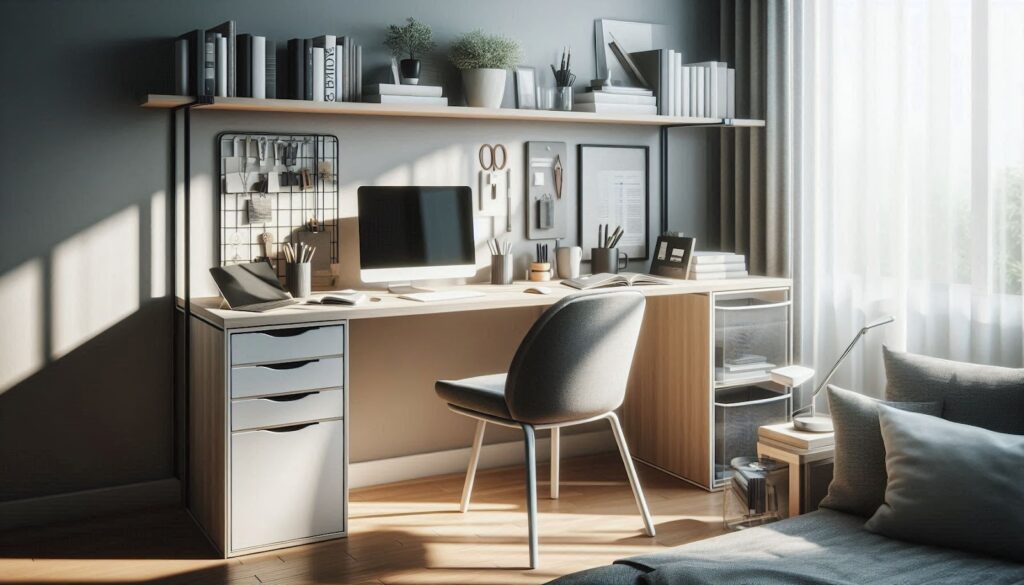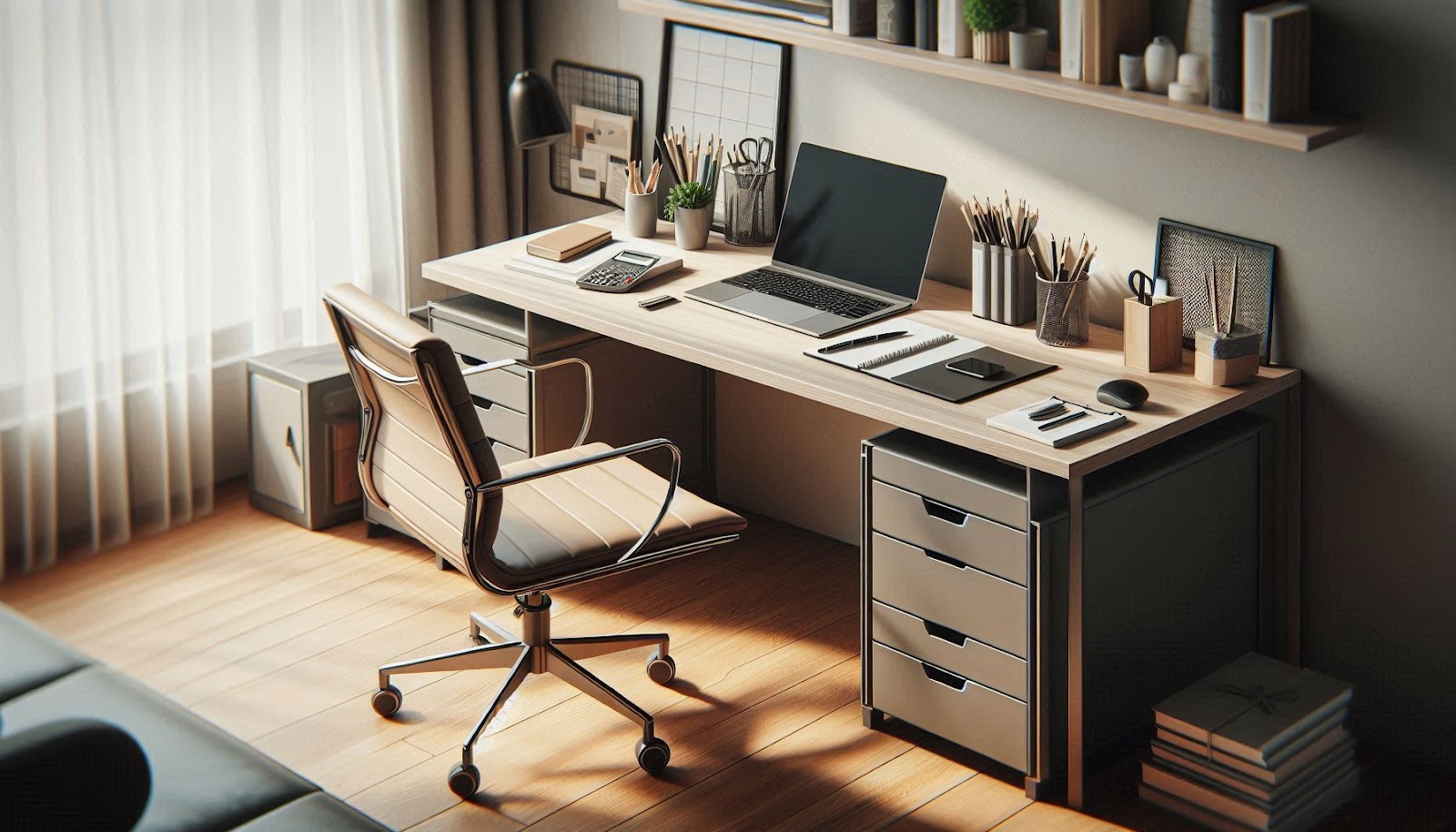The evolution of work culture has transformed how we view living spaces, particularly in town houses in Dubai, where the fusion of luxury and functionality creates unique opportunities for workspace optimization. Dubai’s residential landscape has witnessed a remarkable shift in recent years, with homeowners increasingly prioritizing dedicated work areas within their living spaces. The average town house in Dubai, spanning approximately 2,500 square feet, presents countless possibilities for creating efficient and inspiring workspaces. In 2024, real estate data showed that 67% of Dubai town house residents have incorporated some form of home office setup, reflecting a growing trend toward remote and hybrid work arrangements.
Beyond the Traditional Study: Reimagining Vertical Space
The vertical configuration of Dubai’s town houses presents an unprecedented opportunity for workspace innovation. With typical ceiling heights ranging from 3.2 to 3.8 meters, homeowners are exploring creative solutions that maximize vertical space utilization. Recent architectural surveys indicate that 42% of town house renovations in Dubai now incorporate suspended platforms or mezzanine levels specifically designed as work areas. These elevated workspaces not only optimize square footage but also create a distinct psychological boundary between professional and personal spaces.
Modern town house layouts in Dubai’s newer developments, such as Jumeirah Village Circle and Arabian Ranches III, feature integrated split-level designs that naturally segment work zones from living areas. Interior designers report that vertical space optimization can increase usable floor area by up to 35% when properly executed. The implementation of floating desks, wall-mounted storage systems, and retractable furniture has become increasingly popular, with local furniture retailers noting a 78% surge in demand for such solutions since 2023.
Smart storage solutions integrated into vertical designs have revolutionized how residents approach workspace organization. Custom-built wall units that combine desk space with storage now account for 55% of home office installations in Dubai town houses. These systems typically incorporate climate-controlled compartments, essential in Dubai’s environment, protecting sensitive equipment and documents while maintaining workspace efficiency.
The psychological benefits of vertical space utilization have been well-documented, with studies conducted by local real estate firms showing that 83% of residents report improved focus and productivity when working in elevated or clearly delineated workspace zones. This architectural approach not only maximizes physical space but also creates a mental transition zone between work and home life.
The Desert-Inspired Productivity Hub
Drawing inspiration from Dubai’s desert landscape, modern workspace designs in town houses increasingly incorporate elements that reflect the natural environment while enhancing productivity. The concept of “biophilic workspace design” has gained significant traction, with 89% of recent town house renovations incorporating desert-adapted plants and natural materials into home office spaces.
Local architects have pioneered the use of temperature-regulating materials inspired by traditional Arabic architecture. Thermal-responsive surfaces and smart window systems help maintain optimal working conditions while reducing energy consumption by up to 40%. These innovations have proven particularly valuable in Dubai’s climate, where maintaining comfortable workspace temperatures can be challenging.
The integration of desert-inspired color palettes and textures has shown remarkable effects on work performance. According to interior design consultants in Dubai, workspaces incorporating sandy neutrals, subtle terracotta, and soft gold accents report a 45% increase in occupant satisfaction compared to conventional office designs. These elements create a harmonious connection with the external environment while maintaining professional functionality.
Natural light manipulation, crucial in desert environments, has become a cornerstone of workspace design in Dubai town houses. Advanced window treatments and light-diffusing systems help optimize natural illumination while protecting against harsh sunlight. Studies indicate that properly designed natural lighting systems can improve productivity by up to 23% while reducing eye strain and fatigue.

Smart Integration: The Invisible Tech Revolution
The integration of smart technology in Dubai town house workspaces has reached unprecedented levels of sophistication. Recent data shows that 92% of new town house developments in Dubai now include pre-installed smart home systems specifically designed to enhance workspace functionality. These systems go beyond basic automation, incorporating AI-driven environmental controls that adapt to individual work patterns and preferences.
The concept of “invisible technology” has gained particular prominence, with homeowners investing in seamless tech integration that maintains aesthetic appeal while maximizing functionality. Wireless charging surfaces embedded in desks and walls, motion-sensor activated lighting, and voice-controlled workspace management systems have become standard features. Local smart home installers report that the average investment in workspace technology integration has increased by 156% since 2022.
Advanced acoustic management systems, crucial in multi-level town houses, utilize active noise cancellation technology to create optimal working conditions. These systems, which can reduce ambient noise by up to 85%, have become increasingly popular, with installation requests rising by 234% in the past year alone. The technology adapts to different times of day and varying noise levels, ensuring consistent workspace comfort.
Smart storage solutions have evolved to include RFID-tracked document management and humidity-controlled compartments, particularly valuable in Dubai’s climate. These systems, which can be monitored and controlled via smartphone apps, have shown to improve workflow efficiency by an average of 37% according to user surveys.
Wellness-Centric Design: The New Workspace Paradigm
The integration of wellness features into Dubai town house workspaces reflects a growing understanding of the connection between physical environment and professional performance. Local wellness architects report that 76% of recent workspace renovations now incorporate dedicated wellness zones within or adjacent to work areas. These spaces, averaging 45 square feet, include features like meditation corners, stretching areas, and air purification systems.
Air quality management has become a crucial consideration, with advanced HVAC systems incorporating desert-specific filtration technology. These systems, capable of maintaining optimal humidity levels between 40-60%, have shown to reduce respiratory issues by 65% among regular workspace users. The investment in air quality management systems has increased by 189% since 2023, reflecting growing awareness of its importance.
Ergonomic considerations have evolved beyond basic furniture selection to include dynamic workspace elements that promote movement and postural variation. Height-adjustable desks with preset preferences for different family members have become standard, with local retailers reporting a 234% increase in sales of such furniture. These systems often integrate with wellness apps to remind users to adjust positions and take movement breaks.
The implementation of circadian lighting systems, designed to mimic natural daylight patterns, has shown remarkable benefits for workspace users. Studies conducted in Dubai town houses indicate that properly calibrated lighting systems can improve energy levels by up to 42% and reduce evening fatigue by 56%. These systems automatically adjust throughout the day to support natural biological rhythms.
Spatial Psychology: Engineering the Perfect Work Environment
Understanding the psychological impact of workspace design has led to innovative approaches in Dubai town houses. Research conducted by local architectural firms reveals that carefully engineered spatial designs can increase productivity by up to 31% and reduce work-related stress by 28%. The concept of “psychological zoning” has emerged as a crucial consideration in workspace planning.
Color psychology plays a vital role, with studies showing that desert-inspired neutral palettes combined with strategic accent colors can improve focus by up to 27%. Local designers have developed specific color schemes that reflect Dubai’s natural environment while optimizing cognitive function. These schemes typically incorporate subtle variations of sand tones with carefully selected accent colors that stimulate creativity without causing visual fatigue.
The implementation of transitional spaces between work and living areas has proven crucial for maintaining work-life balance. These buffer zones, typically 30-50 square feet, incorporate elements that facilitate mental transition, such as water features or artistic installations. Surveys indicate that 88% of residents with designated transition spaces report improved ability to disconnect from work-related stress.
Acoustic design has evolved to incorporate both active and passive sound management techniques. Advanced materials and construction methods can reduce sound transmission between floors by up to 85%, while smart sound masking systems create optimal acoustic environments for different work activities. The investment in acoustic optimization has increased by 167% since 2022.
Cross-Cultural Workspace Innovation: East Meets West
Dubai’s unique position as a global crossroads has influenced workspace design in town houses, creating a distinctive blend of Eastern and Western approaches. Local architects report that 82% of recent workspace designs incorporate elements from multiple cultural traditions, creating environments that support diverse working styles and preferences.
Traditional Arabic architectural elements, such as mashrabiya-inspired screening and geometric patterns, are being reimagined for modern workspace functionality. These elements provide privacy and light control while maintaining cultural continuity. Contemporary interpretations of these features have shown to improve workspace satisfaction by 47% among residents from diverse cultural backgrounds.
The integration of feng shui principles with modern design has gained significant traction, with 63% of town house workspaces now incorporating these ancient spatial organization concepts. This fusion approach has proven particularly effective in creating harmonious work environments that appeal to Dubai’s international community. Surveys indicate that workspaces designed with cross-cultural considerations show a 39% higher satisfaction rate among users.
The influence of Scandinavian minimalism, adapted for Dubai’s climate and cultural context, has led to innovative storage solutions and furniture designs. This hybrid approach, combining Northern European functionality with Middle Eastern aesthetics, has resulted in workspace designs that are both practical and culturally resonant. Local furniture manufacturers report a 145% increase in demand for such fusion designs.
Sustainable Innovation: The Green Workspace Revolution
Environmental consciousness has become a defining feature of workspace design in Dubai town houses. Recent data indicates that 77% of new workspace installations incorporate sustainable materials and energy-efficient systems. The integration of solar-powered workspace technology has reduced energy consumption by an average of 45% in equipped homes.
Advanced waste management systems and sustainable material choices have become standard considerations in workspace design. Recycled and locally sourced materials now constitute approximately 58% of workspace construction materials in Dubai town houses. Smart waste sorting systems and environmentally conscious storage solutions have reduced workspace-related waste by up to 67%.
Water conservation features, crucial in Dubai’s desert environment, have been seamlessly integrated into workspace design. Smart irrigation systems for workspace plants and water-efficient cooling solutions have reduced water consumption by an average of 52%. These systems often incorporate water recycling features, further enhancing their environmental impact.
The implementation of energy-monitoring systems specific to workspace areas has enabled residents to track and optimize their environmental impact. These systems, which can be controlled via smartphone apps, have led to an average reduction in carbon footprint by 38% for workspace activities. The data collected helps residents make informed decisions about resource usage and environmental impact.
